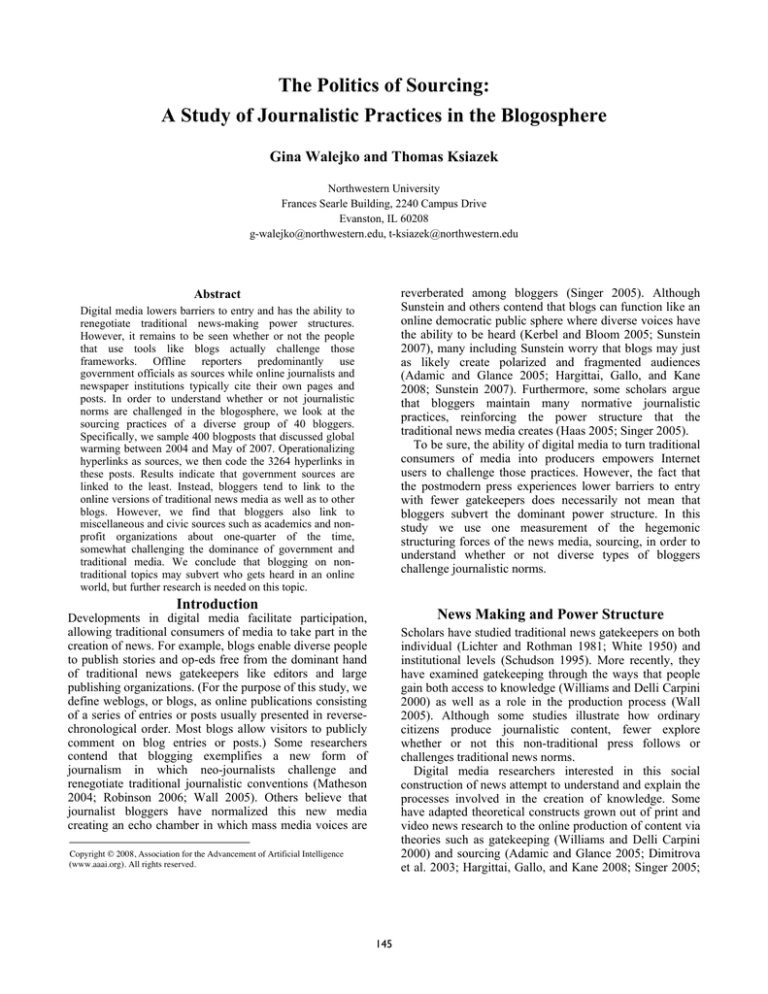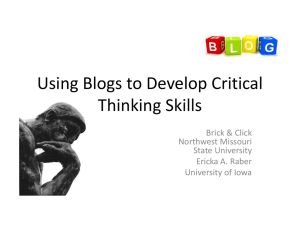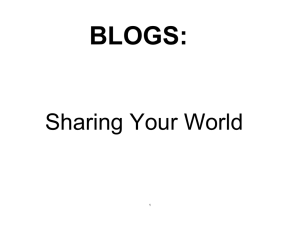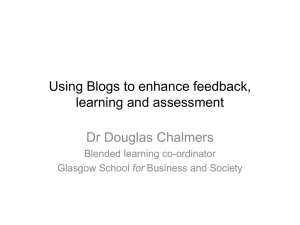
The Politics of Sourcing:
A Study of Journalistic Practices in the Blogosphere
Gina Walejko and Thomas Ksiazek
Northwestern University
Frances Searle Building, 2240 Campus Drive
Evanston, IL 60208
g-walejko@northwestern.edu, t-ksiazek@northwestern.edu
reverberated among bloggers (Singer 2005). Although
Sunstein and others contend that blogs can function like an
online democratic public sphere where diverse voices have
the ability to be heard (Kerbel and Bloom 2005; Sunstein
2007), many including Sunstein worry that blogs may just
as likely create polarized and fragmented audiences
(Adamic and Glance 2005; Hargittai, Gallo, and Kane
2008; Sunstein 2007). Furthermore, some scholars argue
that bloggers maintain many normative journalistic
practices, reinforcing the power structure that the
traditional news media creates (Haas 2005; Singer 2005).
To be sure, the ability of digital media to turn traditional
consumers of media into producers empowers Internet
users to challenge those practices. However, the fact that
the postmodern press experiences lower barriers to entry
with fewer gatekeepers does necessarily not mean that
bloggers subvert the dominant power structure. In this
study we use one measurement of the hegemonic
structuring forces of the news media, sourcing, in order to
understand whether or not diverse types of bloggers
challenge journalistic norms.
Abstract
Digital media lowers barriers to entry and has the ability to
renegotiate traditional news-making power structures.
However, it remains to be seen whether or not the people
that use tools like blogs actually challenge those
frameworks. Offline reporters predominantly use
government officials as sources while online journalists and
newspaper institutions typically cite their own pages and
posts. In order to understand whether or not journalistic
norms are challenged in the blogosphere, we look at the
sourcing practices of a diverse group of 40 bloggers.
Specifically, we sample 400 blogposts that discussed global
warming between 2004 and May of 2007. Operationalizing
hyperlinks as sources, we then code the 3264 hyperlinks in
these posts. Results indicate that government sources are
linked to the least. Instead, bloggers tend to link to the
online versions of traditional news media as well as to other
blogs. However, we find that bloggers also link to
miscellaneous and civic sources such as academics and nonprofit organizations about one-quarter of the time,
somewhat challenging the dominance of government and
traditional media. We conclude that blogging on nontraditional topics may subvert who gets heard in an online
world, but further research is needed on this topic.
Introduction
News Making and Power Structure
Developments in digital media facilitate participation,
allowing traditional consumers of media to take part in the
creation of news. For example, blogs enable diverse people
to publish stories and op-eds free from the dominant hand
of traditional news gatekeepers like editors and large
publishing organizations. (For the purpose of this study, we
define weblogs, or blogs, as online publications consisting
of a series of entries or posts usually presented in reversechronological order. Most blogs allow visitors to publicly
comment on blog entries or posts.) Some researchers
contend that blogging exemplifies a new form of
journalism in which neo-journalists challenge and
renegotiate traditional journalistic conventions (Matheson
2004; Robinson 2006; Wall 2005). Others believe that
journalist bloggers have normalized this new media
creating an echo chamber in which mass media voices are
Scholars have studied traditional news gatekeepers on both
individual (Lichter and Rothman 1981; White 1950) and
institutional levels (Schudson 1995). More recently, they
have examined gatekeeping through the ways that people
gain both access to knowledge (Williams and Delli Carpini
2000) as well as a role in the production process (Wall
2005). Although some studies illustrate how ordinary
citizens produce journalistic content, fewer explore
whether or not this non-traditional press follows or
challenges traditional news norms.
Digital media researchers interested in this social
construction of news attempt to understand and explain the
processes involved in the creation of knowledge. Some
have adapted theoretical constructs grown out of print and
video news research to the online production of content via
theories such as gatekeeping (Williams and Delli Carpini
2000) and sourcing (Adamic and Glance 2005; Dimitrova
et al. 2003; Hargittai, Gallo, and Kane 2008; Singer 2005;
Copyright © 2008, Association for the Advancement of Artificial Intelligence
(www.aaai.org). All rights reserved.
1
145
Wall 2005). The growing popularity of blogs and their
tendency to focus on hot-button issues has enticed many
scholars to use this medium to test such ideas. In this study
we examine whether or not bloggers diverge from
traditional journalistic conventions, looking specifically at
the sources that bloggers use when constructing and
creating online content.
abundance of research in a variety of traditional news
media contexts, all providing the same result; government
sources dominate the news.
The corollary to these findings is a lack of civil or nongovernmental sources in traditional news media. Lacy and
Coulson found that journalists marginalized civil sources
in coverage of the Clean Air Act (2001). Hallin and
colleagues reported only 5.8 percent civil sources in
coverage by national security reporters (Hallin, Manoff,
and Weddle 1993). Interestingly, even a study of an
alternative newspaper in the U.K. found very few non-elite
sources (Atton and Wickenden 2005). Sourcing patterns of
traditional news media reinforce the dominant knowledge
structure, assigning authority, credibility, and legitimacy to
government officials while simultaneously pushing
civilians to the margins.
Sourcing in Offline News
The sources that journalists use to tell their stories are one
example of the power structure that supports normative
journalistic practices. Sourcing studies attempt to discern
this framework as information ebbs and flows between
both online and offline producers and consumers of
content. Understanding whom journalists cite in news
stories indicates whom they value. Furthermore, those who
are cited have the ability to gain power as their voices and
opinions are published. As the adage goes, “No news is
bad news.”
Journalists heavily cite the government. Previous studies
of traditional news media reveal that the government,
government officials and elite voices dominate sources
(Althaus et al. 1996; Brown et al. 1987; Entman and Page
1994; Hallin, Manoff, and Weddle 1993; Lacy and
Coulson 2001; Sigal 1973). In doing so, these journalists
bestow a level of legitimacy and credibility to sources
associated with political administrations. In an early study
of news citations, Sigal analyzed the sourcing practices of
The New York Times and The Washington Post over a
twenty-year period, discovering that eight out of ten
sources were affiliated with the government (1973). More
than a decade later, Sigal’s study was replicated with the
inclusion of four North Carolina newspapers to test for
differences between newspapers with national and local
circulations (Brown et al. 1987). The results were nearly
identical. These findings support traditional news media’s
preferences for government voices.
Other studies have looked at specific events or issues in
order to understand whether some types of news are more
prone to citing government sources. In 1993, Hallin and
colleagues discovered that government sources comprised
75 percent of the total citations by national security
reporters for The New York Times, The Washington Post,
the Los Angeles Times, The Boston Globe, The Wall Street
Journal, The Washington Times, and the Chicago Tribune.
Coverage of the Gulf War relied similarly on government
sources (Entman and Page 1994). Althaus and colleagues
measured coverage of the U.S.-Libya crisis of 1985-1986
in The New York Times, discovering that foreign
government sources dominated the topic. When combined
with U.S. government sources, the authors credited 91
percent of the total sources to some type of government
official (1996). Even a study of the sourcing patterns of
environmental beat reporters found that government
sources dominated, and these journalists tended to
marginalize consumers and environmentalists (Lacy and
Coulson 2001). Thirty years of sourcing studies show an
Sourcing in Digital Media
Research on sourcing in digital media paints a different
picture, revealing an alternative but equally elite
knowledge structure where the online versions of
traditional news media sit atop a hierarchy of authority
once again diminishing civilian voices. Viewing hyperlinks
as sources, blogs and online news media extensively cite
the webpages of traditional news media (Williams et al.
2005). An analysis of the blogosphere during the 2004
presidential campaign reported that political bloggers
linked to the traditional news media 61 percent of the time
(BlogPulse 2004). Blogs and online news sites commonly
link to internal articles or sources within their own online
pages further diminishing diverse voices (Dimitrova et al.
2003; Williams et al. 2005). For example, in an analysis of
fifteen online newspapers reporting on the Timothy
McVeigh execution, Dimitrova and colleagues found 94.8
percent of hyperlinks to be internal (2003). Digital media
outlets tend to cite internal pages as well as the online
versions of traditional news media (BlogPulse 2004;
Dimitrova et al. 2003; Williams et al. 2005).
Unfortunately, many of these studies have chosen to
focus only on political topics, political bloggers or online
news sources in which one would expect government
sources and traditional news media sources to dominate
(i.e. BlogPulse 2004; Williams et al. 2005). They do not
aim to understand whether or not blogging about fringe
topics has the ability to subvert power hierarchies.
Alternatively, the present study analyzes the sources of a
diverse set of bloggers surrounding both a scientific and
political topic, global warming. We specifically ask the
following research question:
Do the sourcing practices of bloggers differ from the
sourcing practices reported in previous sourcing studies
and, if so, how?
146
Table 1. List of sampled blogs
Sample and Methods
In this study, we explore 40 political and science blogs.
Today, the blog-tracker, Technorati, tracks over 112
million weblogs (Technorati 2008). A January 2006 Pew
Internet and American Life survey shows that 39 percent
of Internet users ages eighteen and over have read blogs,
while eight percent have created blogs (Lenhart and Fox
2006). Popular political blogs like The Daily Kos report
over 650,000 visits per day, on average. In comparison,
The Chicago Tribune reported a Sunday highest circulation
of 937,907 in September of 2006 (Top 200 newspapers
2006). These statistics hint at the importance of blogs in
the production of online news.
Specifically, we sampled twenty political (ten liberal and
ten conservative) blogs and twenty science blogs that
discussed global warming in at least ten of their blogposts
between 2004 and 2007. (See Table One for a list of
blogs.) The “culture war” over global warming provides a
fertile topic with which to access the sourcing practices of
a diverse group of bloggers including political and science
authors. Much research into blogs as a form of news
concentrates on political bloggers and political processes
such as elections and campaigns (BlogPulse 2004;
Lawson-Borders and Kirk 2005; Singer 2005). By focusing
on global warming, we are able to examine a bipartisan
issue that promotes heated debate both inside and outside
the political sphere. Recall that Lacy and Coulson
examined coverage of the Clean Water Act, finding that 82
percent of total sources were government or business while
science and environmental sources accounted for only six
percent of total citations (2001). Some have argued that
blogging allows non-traditional voices to be heard (Wall
2005), and studying an environmental topic such as global
warming allows us to test such an assumption.
Due to the difficulty of sampling web-based populations
(Andrews, Nonnecke, and Preece 2003; Kaye and Johnson
1999; Li and Walejko 2008), we employed sampling
techniques that best suited our populations of interest:
political and science blogs. We defined political blogs as
those that self-identified as political blogs. For example, a
blog that used the word “liberal” in the “About” section or
title of their blog was assumed to be left-leaning; thus, we
categorized the blog as “liberal.” In some cases, political
blogs and conservative/liberal blogs were inferred by their
content. Past research also informed the distinctions
between liberal and conservative blogs (Adamic and
Glance 2005; Hargittai, Gallo, and Kane 2008). Similarly,
we defined science blogs as those that self-identified as
science blogs, those that were published through the metasite ScienceBlogs, or those that were written by individuals
claiming to be scientists at a university.
We sampled political blogs based on popularity,
utilizing the ranking systems of BlogPulse, Technorati, and
Truthlaidbear to select those blogs that ranked highest. For
science blogs, we employed a ranking system based on
BlogPulse and Technorati. (Because Truthlaidbear focuses
on the highest ranked blogs in the blogosphere they do not
Political
Science
Bring It On [L]
Bad Astronomy
Captain’s Quarters [C]
A Blog Around the Clock
Crooks and Liars [L]
Climate Science
Daily Kos [L]
Deltoid
Eschaton [L]
A Few Things Ill Considered
Hugh Hewitt [C]
The Frontal Cortex
The Jawa Report [C]
The Intersection
Jesus’ General [L]
Living the Scientific Life
Little Green Footballs [C]
The Loom
Michelle Malkin [C]
Migrations/
A Concerned Scientist
Outside the Beltway [C]
Mike the Mad Biologist
Power Line [C]
Pharyngula
Red State [C]
Prometheus
Right Wing News [C]
Pure Pedantry
Skippy the Bush Kangaroo
[L]
RealClimate
Shakespeare’s Sister [L]
The Scientific Activist
Talking Points Memo [L]
SciGuy
Think Progress [L]
Stayin’ Alive
The Volokh Conspiracy [C]
Stoat
Wonkette [L]
Thoughts from Kansas
[L] Liberal; [C] Conservative
rank many science blogs.) In general, science blogs tend to
be less popular and lower ranked than political blogs. For
this reason, we also used awards as a ranking criterion for
this portion of the sample. We gave extra consideration to
blogs that had won the 2005 Scientific American Science
and Technology Web Award even if they were not highly
ranked in Technorati and BlogPulse. It should be noted that
just because we sampled the most popular science and
political blogs does not mean that our sample consisted of
only extremely popular blogs. In fact, most science blogs
are relatively unpopular when compared to political blogs.
For example, Technorati ranks the most popular science
blog sampled, Pharyngula, only 307th.
From these ranking systems, we employed quota
sampling until we had obtained a list of ten liberal, ten
conservative and twenty science blogs with ten or more
posts on global warming. That is, we compiled lists of the
highest-ranking conservative, liberal and science blogs,
giving preference to those that ranked high on multiple
lists. We then worked down each list in ascending order
examining whether each blog had at least ten posts on
global warming and stopping when we had filled our
quotas.
147
We placed several constraints on the sampling frame
including limiting our sample to English-language blogs
that contained ten or more posts on the topic of global
warming. In order to establish whether or not blogposts
were about global warming, we searched each blog for the
phrase “global warming,” using either an internal search
engine or limiting a Google search to the parent website.
We then counted the number of posts for each blog,
generating ten random numbers in this range. These ten
random numbers represented the posts that we sampled.
Before including each randomly selected blogpost in the
sample, we read the post for content. We did not sample
posts that mentioned the phrase “global warming” in
passing. When this did occur, we sampled the next
chronological post. Due to the fecundity of many bloggers,
we limited our post search to the timeframe between the
months of January 2004 and May 2007. For each post, we
recorded the name, date and author of the post as well as a
link to the post.
We then coded each source in each post, analyzing 3264
hyperlinks and eight non-hyperlinked sources in total. Due
to the extremely low number of non-hyperlinked sources,
subsequent analysis includes only hyperlinked sources.
Whereas traditional news media use quotations as a
legitimizing tool for the objective news standard (Tuchman
1972), hyperlinks can be substituted for quotations in an
online arena (Dimitrova et al. 2003; Singer 2005; Williams
et al. 2005). Similar to the way in which traditional news
media use quotes to signify authoritative knowledge,
bloggers use hyperlinks to assign legitimacy and
renegotiate the online hierarchical knowledge structure.
Matheson argues that “a kind of mesh of authority is built
up where the weblog’s linking accords a certain status to
the linked article” (2004). Furthermore, most digital media
sourcing studies use hyperlinks as sources.
For the purposes of this study, we used a source as our
unit of analysis. We developed a coding schema based on a
pre-study subsample of blogs and blogposts, as well as
categories used in previous studies. These coding
categories were then applied to the entire sample of
sources. We analyzed each hyperlink in a sampled
blogpost, disregarding all links in the sidebars, headers or
footers of the sampled blogs. Coding categories included
blogs, traditional news sources, government sources and
other sources including academic, non-profit and reference
websites. For example, a hyperlink was coded
“newspaper” if it linked to a website or article in an online
version of a newspaper. Both hyperlinked and nonhyperlinked sources were coded using the same categories.
We achieved an intercoder reliability score of .83.
In order to measure the relative proportions of each
source-type, we aggregated the hyperlinks and assigned
each to one of three groups: liberal, conservative or
science. We then summed the number of hyperlinks and
calculated the percent of total hyperlinks for each sourcetype in each group. Using proportional measures allowed
us to control for blogs that may have had more or less
hyperlinks as well as address the potential of a skewed data
distribution.
The Sourcing Practices of Bloggers
Most research shows that government sources dominate
offline and broadcast media (Althaus et al. 1996; Brown et
al. 1987; Entman and Page 1994; Hallin, Manoff, and
Weddle 1993; Lacy and Coulson 2001; Sigal 1973). The
results of this study indicate much different sourcing
patterns in the blogosphere. (See Table Two for a complete
breakdown of hyperlinked sources.) We find that
government sources comprise less than four percent of all
sources. This figure appears even more profound when one
recalls that even sourcing studies that focused on
environmental reporting (Lacy and Coulson 2001) found
that government sources account for upwards of 70 percent
of total sources. This difference is most likely due to the
fact that websites and online newspapers often use
secondary sources. In fact, online research shows that
internal links and links to online versions of traditional
news media dominate sources (BlogPulse 2004; Dimitrova
et al. 2003; Williams et al. 2005).
This study partially supports previous research on the
sourcing practices of digital news media that report that
traditional media sources dominate (BlogPulse 2004;
Singer 2005; Williams et al. 2005). In this study,
traditional news sources account for 35.6 percent of all
sources. This proportion is nowhere near the 61 percent
reported by BlogPulse, but it does indicate a strong
relationship between journalists and the mainstream media.
A 2005 survey of 1,202 journalists from around the world
indicated that most journalists utilize blogs for their jobs,
and nearly 70 percent report using them for work-related
activities. In fact, the study reports that 33 percent use
them to stay informed with breaking news while over onequarter (28%) use them for daily reporting (Euro RSCG
Magnet 2005). A 2007 study supports these claims,
showing that one quarter of journalists agree that “blogs
make their job easier and one-fifth have reported on stories
that originated on a blog. Furthermore, over one-half of the
journalists interviewed say that they get story ideas from
blogs (Arketi Group 2007).
In partial support of previous research on the sourcing
patterns of digital media, we also find that bloggers link
extensively to other blogs (27.8%). Bloggers link to blogs
in general 34.9 percent of the time although they
infrequently link to internal pages (7.1%) Recall that
Dimitrova and colleagues found 94.8 percent of hyperlinks
in online newspapers to be internal (Dimitrova et al. 2003).
Possibly reflecting a mild preference for secondary
rather than tertiary sources, this percentage may be lower
than expected because bloggers choose to cite traditional
news media (secondary) instead of blogs (tertiary). To
clarify this distinction, a primary source would be the
original offline source cited in an article posted to a
traditional news media website. A secondary source would
be a blogger citing that article while a tertiary source
148
would be a blogger citing another blogger who cites the
traditional news media article.
retailers, video websites and other sources that did not fit
into our coding schema. Future research should expand and
explain these coding categories in order to minimize the
percentage of miscellaneous citations.
In addition to revising the coding schema, the present
study could be strengthened by extending it in three ways.
First, replicating the present study on another topic would
contribute to its generalizability. Second, increasing the
sample size would allow for more rigorous statistical tests
of intergroup differences (e.g. t-test comparing means
between political and science bloggers). Finally, extending
the study to primary sources would improve our
comprehension of power and knowledge structures existing
between bloggers and their sources, both online and
offline.
Table 2. Within group percentages of hyperlinked sources
Liberal
Cons.
Pol.
Total
Sci.
Total
35.5
29.2
33.1
35.4
34.9
Other
13.6
21.1
16.5
30.4
27.8
Own
21.9
8.1
16.6
5
7.1
33.0
37.5
34.7
35.7
35.6
20.8
17.9
19.7
12.1
13.5
Blogs
Traditional
News
Newspaper
Magazine
2.7
4
3.2
2.6
2.7
Radio
0.3
0.9
0.5
0.9
0.9
Television
4.1
3.1
3.7
3.6
3.6
Web
4.6
4
4.4
6.2
5.9
Other
0.5
7.6
3.2
10.3
9
Gov.
5.2
3.6
4.6
3.3
3.5
Other
26.2
29.6
27.6
25.7
25.9
Academic
1.1
1.8
1.4
6.4
5.5
Non-profit
7.6
1.3
5.3
3.7
4
Reference
1.1
0.9
1
1.2
1.1
Misc.
Website
16.4
25.6
19.9
14.4
15.3
Blogging, Sourcing and the Importance of
Online Media Events
In previous research on the sourcing practices of both
offline and online media, journalists used government and
traditional media as sources (Althaus et al. 1996;
BlogPulse 2004; Brown et al. 1987; Entman and Page
1994; Hallin, Manoff, and Weddle 1993; Lacy and
Coulson 2001; Sigal 1973; Singer 2005; Williams et al.
2005), simultaneously marginalizing civilian voices even
when reporting on topics such as the environment (Lacy
and Coulson 2001). The present study unearths a different
pattern; bloggers rely equally on other bloggers, traditional
media and miscellaneous and civic sources for referential
source information. Together, blogs, traditional news
media and miscellaneous sources account for 96.4 percent
of total sources. Conversely, government sources amount
to only 3.5 percent of the total percent of sources. It
appears that, rather than predominantly linking to
government sources or traditional news media sources,
bloggers offer nuanced and diverse linking patterns that
include other typically marginalized sources like the
websites of scientists and non-profit organizations.
These sourcing practices contribute to a renegotiation of
the blogospherical power structure where bloggers assign
themselves, traditional and non-traditional online sources
authority, credibility, and legitimacy at varying levels. Just
as journalists rely on blogs for news and reporting,
bloggers seem to rely on traditional news media journalists
for their posts. One could argue that such a renegotiation
encourages an online public sphere where diverse voices
are heard, reminiscent of Sunstein’s hope (2007). In this
way, the blogosphere gives power to experts in niche
topics like science and environment issues.
However, we would do well to recognize that a
renegotiation of power structures in an online world does
not herald in a postmodern form of journalism where
consumers of information become equal producers. The
online news environment still maintains a power structure,
although this architecture shifts as the event-centered
world of traditional news reporting transforms in the
webpage-centered blogosphere.
Perhaps most intriguing, we find that bloggers link to
academic, non-profit, reference and miscellaneous
websites 25.9 percent of the time. Although this proportion
is smaller than traditional news sources and blogs, it
appears sizeable when one recalls that most offline and
online sourcing studies report extremely small percentages
of non-government, non-traditional news media or noninternal links and sources. Whereas most of these sources
are miscellaneous websites (15.3%), academic and nonprofit sources comprise 5.5 and 4.0 percent of these
sources, respectively.
Some of this discrepancy might be explained by the fact
that the global warming debate requires scientific sources.
However, academic sources amount to less than six percent
of total sources in our study. Even political bloggers cite a
large proportion of miscellaneous sources (27.6%). Still,
this difference may be topic-specific. Wall finds that war
blogs fill a gap in mainstream war reporting, emphasizing
things such as personalized content and audience
participation (Wall 2005). The large percentage of
miscellaneous citations in our study may indicate a new
genre where science and environmental topics give
traditionally marginalized sources voice and power.
Unfortunately, the large percentage of miscellaneous
citations is a notable concern. This category consists of a
wide range of personal and group webpages, online
149
Acknowledgements
Haas, T. 2005. From ‘‘public journalism’’ to the ‘‘public’s
journalism’’? Rhetoric and reality in the discourse on
blogs. Journalism Studies 6(3): 387-396.
We thank our coder, Candace Wells. We give extra special
thanks to the School of Communication and the Media,
Technology and Society program for funding this research.
We are also indebted to Professor James Ettema and
Professor Peter Miller for providing helpful feedback and
supporting our project.
Hallin, D. C.; Manoff, R. K.; and Weddle, J. K. 1993.
Sourcing patterns of national security reporters. Journalism
Quarterly 70(4): 753-766.
Hargittai, E.; Gallo, J.; and Kane, M. 2008. Crossideological discussions among conservative and liberal
bloggers. Public Choice 134(1-2): 67-86
References
Adamic, L., and Glance, N. 2005. The political
blogosphere and the 2004 U.S. elections: Divided they
blog. Retrieved 16 November 2006 from
http://www.blogpulse.com/papers/2005/AdamicGlanceBlo
gWWW.pdf.
Kaye, B. K., and Johnson, T. J. 1999. Research
methodology: Taming the cyber frontier. Social Science
Computer Review 17(3): 323-337.
Althaus, S. L.; Edy, J. A.; Entman, R. M.; and Phalen, P.
1996. Revising the indexing hypothesis: Officials, media,
and the Libya Crisis. Political Communication, 13(4), 407421.
Lacy, S., and Coulson, D. C. 2001. Comparative case
study: Newspaper source use on the environmental beat.
Communication Abstracts 24(1): 13-25.
Kerbel, M. R., and Bloom, J. D. 2005. Blog for America
and civic involvement. Press/Politics 10(4): 3-27.
Lawson-Borders, G., and Kirk, R. 2005. Blogs in campaign
communication. American Behavioral Scientist 49(4): 548559.
Andrews, D.; Nonnecke, B.; and Preece, J. 2003.
Electronic survey methodology: A case study in reaching
hard-to-involve Internet users. International Journal of
Human-Computer Interaction 16(2): 185-210.
Lenhart, A., and Fox, S. 2006. Bloggers: A portrait of the
Internet's new storytellers. Pew Internet and American Life
Project. Retrieved 16 November 2006 from
http://www.pewinternet.org/PPF/r/186/report_display.asp.
Arketi Group. 2007. Arketi Web Watch: Inside B-to-B
media usage of Web 2.0. Arketi Group. Retrieved 11
February 2008 from http://www.arketi.com/surveys.html.
Li, D. and Walejko, G. 2008. Splogs and abandoned blogs:
The perils of sampling bloggers and their blogs.
Information, Communication and Society 11(2).
Atton, C., and Wickenden, E. 2005. Sourcing routines and
representation in alternative journalism: A case study
approach. Journalism Studies 6(3): 347-359.
Lichter, S. R., and Rothman, S. 1981. Media and business
elites. Public Opinion October/November(4): 42-46.
BlogPulse. 2004. Bloggers' preferred sources of
information. BlogPulse Campaign Radar 2004. Retrieved
16 November 2006 from
http://politics.blogpulse.com/politics_summary.html#blogg
erspreferredsources.
Matheson, D. 2004. Blogs and the epistemology of the
news: Some trends in online journalism. New Media and
Society 6(4): 443-468.
Robinson, S. 2006. The mission of the j-blog. Journalism
Studies: 7(1): 65-83.
Brown, J. D.; Bybee, C. R.; Wearden, S. T.; and Straughan,
D. M. 1987. Invisible power: Newspaper news sources and
the limits of diversity. Journalism Quarterly 64(1): 45-54.
Schudson, M. 1995. The power of news. Cambridge,
Mass.: Harvard University Press.
Dimitrova, D. V.; Connolly-Ahern, C.; Williams, A. P.;
Kaid, L. L.; and Reid, A. 2003. Hyperlinking as
gatekeeping: Online newspaper coverage of the execution
of an American terrorist. Journalism Studies 4(3): 401-414.
ScienceBlogs. 2006. About scienceblogs.com. Retrieved
20 November 2006 from
http://www.scienceblogs.com/channel/about.php
Entman, R. M., and Page, B. I. 1994. The news before the
storm: The Iraq War debate and the limits to media
independence. In L. W. Bennett and D. L. Paletz. Eds.
Taken by storm: The media, public opinion, and U.S.
foreign policy in the Gulf War. Chicago, Illinois:
University of Chicago Press.
Sigal, L. V. 1973. Reporters and officials: The organization
and politics of newsmaking. Lexington, Mass.: D. C.
Heath.
Euro RSCG Magnet and Columbia University Survey of
Media. 2005. Retrieved 11 February 2008 from
http://www.eurorscgpr.com/index.php?s=_thought.
Sunstein, C. R. 2007. Republic.com 2.0. Princeton, New
Jersey: Princeton University Press.
Singer, J. B. 2005. The political j-blogger: 'Normalizing' a
new media form to fit old norms and practices. Journalism
6(2): 173-198.
Technorati. 2008. Technorati. Retrieved 12 February 2008
from http://www.technorati.com/.
150
Top 200 newspapers by largest reported circulation. 2006.
Retrieved 17 November 2006 from
http://www.accessabc.com/reader/top150.htm
Tuchman, G. 1972. Objectivity as strategic ritual: An
examination of newsmen's notions of objectivity. The
American Journal of Sociology 77(4): 660-679.
Wall, M. 2005. 'Blogs of war': Blogs as news. Journalism
6(2): 153-172.
White, D. M. 1950. The gate keeper: A case study in the
selection of news. Journalism Quarterly 27: 383-396.
Williams, A. P.; Trammell, K. D.; Postelnicu, M.;
Landreville, K. D.; and Martin, J. D. 2005. Blogging and
hyperlinking: Use of the Web to enhance viability during
the 2004 US election. Journalism Studies 6(2): 177-186.
Williams, B. A., and Deli Carpini, M. X. 2000. Unchained
reaction: The collapse of media gatekeeping and the
Clinton-Lewinsky scandal. Journalism 1(1): 25.
151




